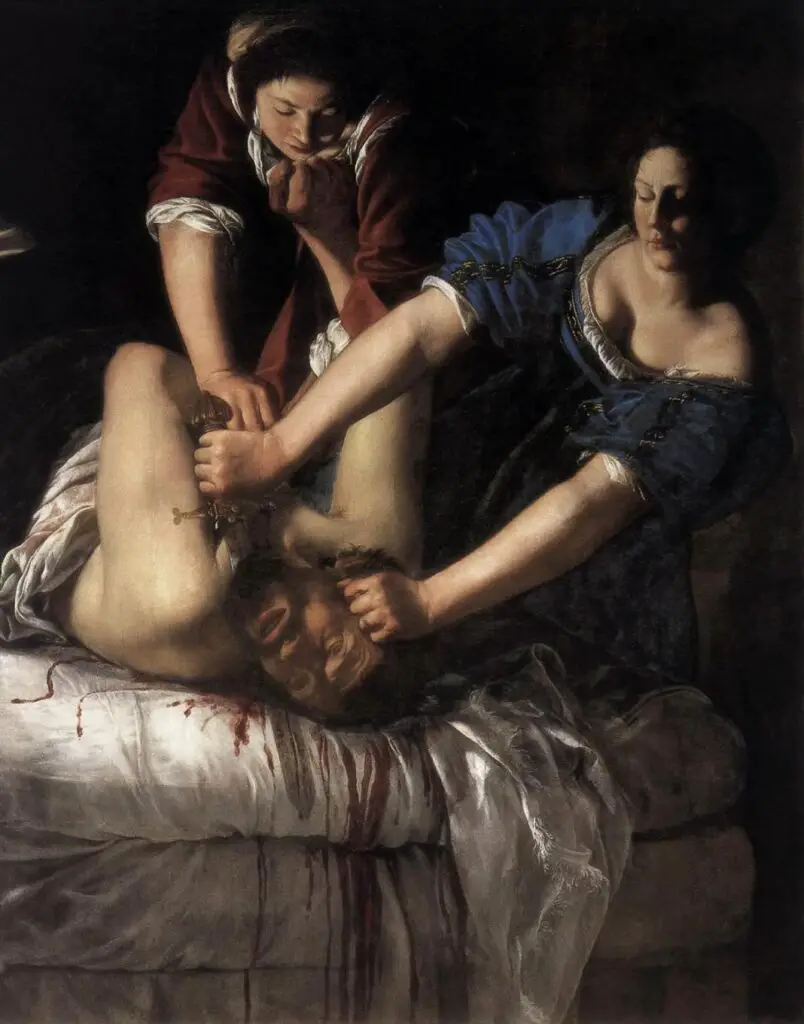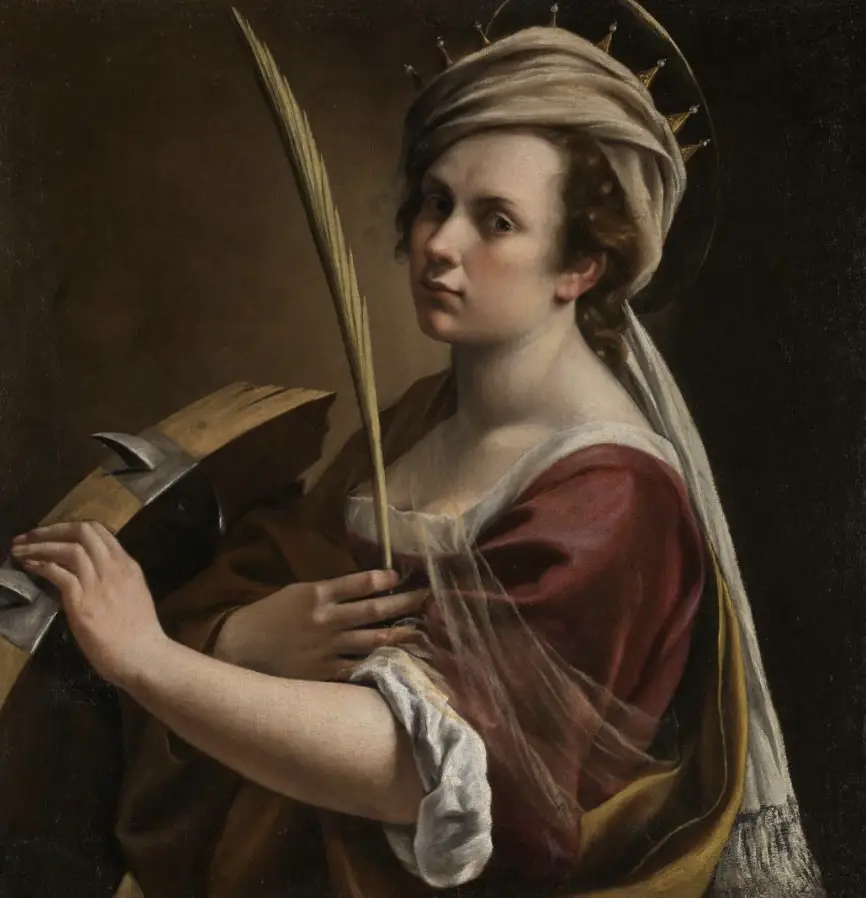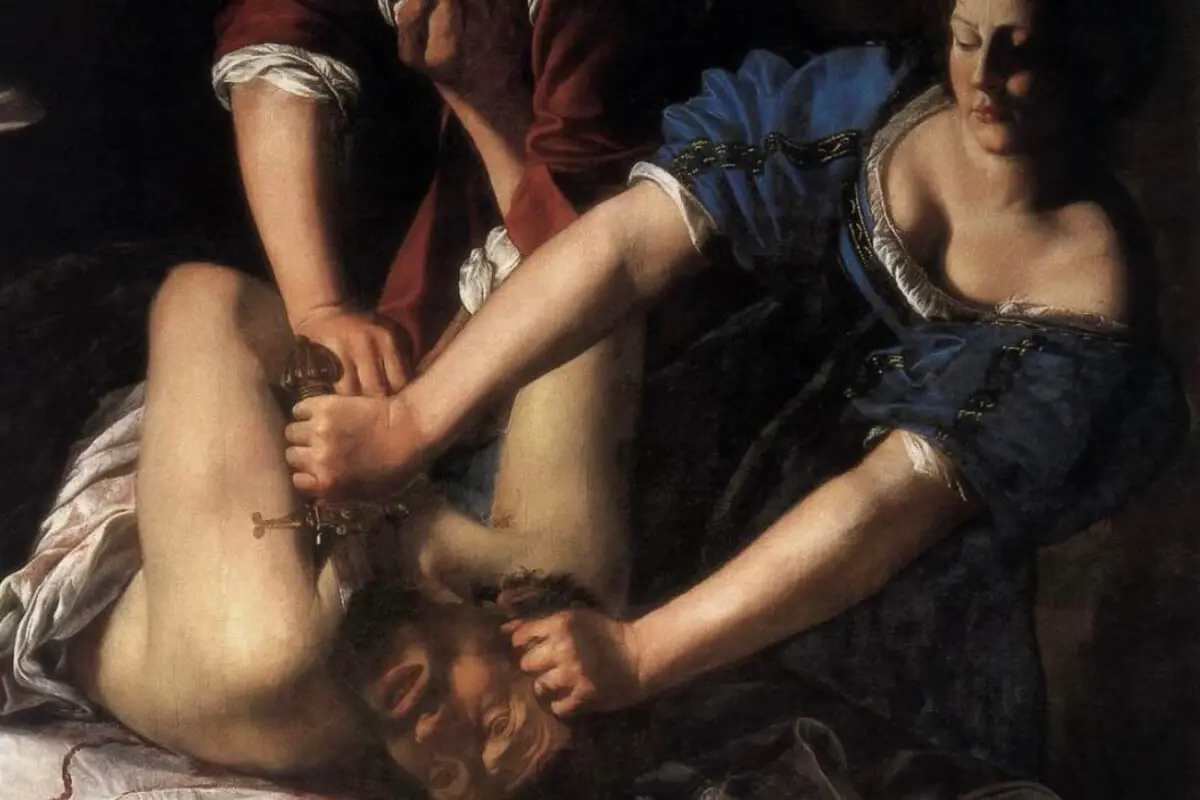In the art world, many masterpieces trace their origins to struggles, challenges, or triumphs experienced by their creators. Among these works that carry within them a unique essence of personal reflection is “Judith Slaying Holofernes” by Artemisia Gentileschi.
This exquisite work of art, narrating a story from the Bible with a novel sense of raw intensity, emerges against Gentileschi’s exhaustive journey and the social realities of her time. It is a commitment to unraveling the intricacies of this painting that will lead us through the corridors of history, to understand the woman behind the artist, to dissect the elements of the composition, and finally to comprehend its resonance as a testament to women’s empowerment in a male rigid art world.
Context of the Artwork
A tumultuous drama of blood, gore, and overpowering courage is immortalized in the notorious masterpiece, “Judith Slaying Holofernes.” This awe-inspiring painting, created by the Baroque artist Artemisia Gentileschi, reflects the socio-cultural moment of its time and carries a powerful autobiographical resonance.

At first glance, one might be taken aback by the brutality in the scene. A closer look, however, reveals a deep sea of symbolism and meaning. Judith, a biblical heroine, is depicted in the act of beheading Holofernes, an Assyrian general. In the biblical narrative, Judith saved her city from destruction by getting Holofernes drunk and subsequently decapitating him.
Gentileschi painted this scene to retell a tale of female bravery and power and to depict the turmoil of her own life. A victim of sexual assault, Gentileschi aligned her narrative with that of Judith’s, turning her trauma into a powerful testament to female resistance and survival.
The fierce determination in Judith’s facial expression, the strength of her stance, and the vivid portrayal of Holofernes’s demise all mirror the artist’s struggle and defiance.
In the broader cultural context, “Judith Slaying Holofernes” arrived during the Baroque period, when art was often used to convey dramatic, emotional, and elaborate narratives. This style was a radical departure from the balanced and harmonious compositions of the Renaissance, reflecting the social unrest and spiritual turmoil of 17th-century Europe.
Styles changed, but the role of women didn’t. Women were widely marginalized in society, and the arts were no exception. Gentileschi was one of the few female artists of her time to gain recognition, and she refused to be defined by her gender. Through artworks like “Judith Slaying Holofernes,” she challenged the traditional portrayal of women as passive and powerless, offering a radically divergent vision of female agency and audacity.
Although “Judith Slaying Holofernes” was produced during the Baroque period, its potent message remains influential today. Artists and art lovers continue to find inspiration in this visceral depiction of female empowerment born out of adversity.
Analysis of the Artwork
Diving further into the visceral imagery of “Judith Slaying Holofernes,” the dark nuances of Gentileschi’s painting paradoxically offer a beacon of inspiration, illuminating the struggle of women and transcending time to resonate with modern audiences.
Judith’s spirit of resistance and resilience echoes deafeningly through the composition, defining one of Artemisia’s masterpieces notable for portraying strong, suffering women.
Relay the vivid portrayal of Judith and her maid, and an observer immediately notices their strength. Gentileschi empowers these women through her distinct departure from her contemporaries in style. Unlike classic images depicting Judith as a delicate damsel reluctantly executing Holofernes, Gentileschi’s Judith, and her maid are physically involved in the beheading, revealing an assertiveness often denied to females in Baroque art.
The unabashed vividness with which violent acts are depicted joins the critical elements embedded in this masterpiece. Artemisia’s light and dark treatments, characterizing the Baroque style, are utilized brilliantly to heighten the dramatic impact. The contrasting depths of shadows and the chilling play of chiaroscuro reinforce the narrative’s gruesome nature and accentuate the struggle and desperation.
Immediate to one’s sight is the blood spilling from Holofernes’ neck, readily indicating the price of tyranny and assault—the stark reality not often revealed in other versions at the time. As shocking as it might be, the blood represents Artemisia’s unfiltered confrontation of her experience, providing the audience with a visual representation of a woman’s retaliation.
The facial expressions of the characters in the painting are eloquent storytellers. Observing Judith pinning down Holofernes’ head and the servant holding the sack for the beheading, one can trace the determination and resolve their faces. Contrarily, Holofernes’ face portrays shock and pain, bringing out the plight of the wrongdoer in the face of justice.
Gentileschi’s bold departure from idealized physical charm is an essential point of note. Judith and her maid are presented not as traditional beauties but as ordinary, relatable women — a courageous break from prevalent norms, further cementing the artist’s commitment to realism and an implicit challenge to societal standards of beauty.
Artistically, the composition is designed to draw your eye not away but into the brutal act in progress. How Gentileschi uses the folds of the bed covering to guide your gaze reflects her technical prowess, defensively asserting her place on the profoundly male-dominated stage of high art across the centuries.
The sublime power of Artemisia Gentileschi’s “Judith Slaying Holofernes” lies in her ability to take a biblical tale and sculpt it to mirror her lived experiences, employed masterfully to relay the timeless testimony of female resistance, empowerment, and survival.
This painting illustrates the narrative of transcending societal and patriarchal constraints from the unflinching perspective of a woman defiantly asserting her voice in a time and space that sought to silence it. Such bravery of expression and technique artistry is why Gentileschi’s Judith—blood-splattered, intense, intriguingly brutal—insists on retelling, reinterpreting, and raging against the dying of the light.

Feminist Interpretation
Feminist art history has routinely queried how women artists have been ignored, erased, or undervalued within traditional narratives. Artemisia Gentileschi’s “Judith Slaying Holofernes” is no exception and has been a vibrant focus of studies examining the depiction of women engaging violently and actively upon men in seventeenth-century art.
An essential aspect of feminism is empowerment, and the portrayal of Judith in Gentileschi’s painting positively personifies this ideal. Stepping away from the traditional damsel-in-distress stereotype, Gentileschi’s Judith is seen as active, powerful, and determined, sharing the act and aftermath of violence with her maid.
Taking a closer look at the painting, the blood, harsh and undeniably virulent, becomes a palpable testament to female strength and resilience. The overwhelming depiction, while shocking, serves as a visual manifestation of the woman’s retaliation against male dominance. This courageously breaks from traditional artistry, where such explicit violence was rarely assigned to female hands.
Though the scene is brutal, Gentileschi’s mastery skillfully communicates the saga made vivid through the characters’ expressions. The determination etched on Judith’s face and the helpless agony of Holofernes – these details add depth and intensity. They illuminate the courage and compassion women are capable of, even in the face of violence, and echo a modern feminist narrative of resilience.
Pushing aside the conventional norms of beauty, Gentileschi presents Judith and her maid in the throes of a gruesome task. They are devoid of ornamental clothing and unnecessary embellishments. The artist’s unconventional portrayal signals that women are more than decorative objects and that beauty can be found even amidst gruesome action and raw determination.
The artist’s impressive composition, balanced, detailed, and groundbreaking in many ways, displays an exceptional understanding of the human body and its exertions – something that was essentially rare in the domain of female artists during that time. This mastery lends credibility to the narrative, effectively silencing critics who negate women’s technical prowess in arts.
Examining the painting from the artist’s lived experience angle yields more profound insights. Gentileschi, herself a victim of assault, painted a narrative that crucially deviated from the way male artists presented Judith.
The feminist interpretation suggests an act of defiance, retaliation against her aggressor, and the societal constraints pressed upon her, reflecting the firm determination of a woman refusing to be silenced.
“Judith Slaying Holofernes” provides a pivotal art-historical moment that encapsulates female artists’ struggle and eventual triumph for recognition. It is an enduring visual proclamation against the patriarchal structure, embodying the spirited resistance characterizing feminist movements throughout centuries.
Artemisia Gentileschi’s spellbinding and brutal tableau continues to inspire and challenge even today, serving as a potent testament to women artists’ intrinsic capacity to revolutionize the perception of female strength and resilience.
Gentileschi’s Influence and Legacy
Artemisia Gentileschi’s masterpiece, “Judith Slaying Holofernes,” is a storied painting that echoes through the halls of art history, blazing trails and smashing preconceived norms.
The unique light shed by Gentileschi on the titular biblical heroine, Judith, swiftly decapitating the Assyrian general, Holofernes, results in a captivating and visceral display of empowerment, strength, and resilience.
While focusing on the central figures of Judith and her maid, Gentileschi shied away from portraying idealized female forms common during the Baroque era. In doing so, she rejected the then-prevailing standards of beauty in favor of representing women’s authentic, raw physicality. This bold approach to the female form amplified the sense of realism and urgency in the painting.
A striking feature is the evocative visuals of her canvas, where Gentileschi uses a striking interplay of lights and shadows, echoing the stylistic tenets of the Baroque period. The vivid and violent imagery is compelling, bordering on horrific, but undeniably profound. The blood gushing from Holofernes’ neck, a grisly tableau that signifies defiance and retaliation, nudges the audience into a continuum where art and stark reality collide.
Beyond the potent imagery, storytelling is woven into the very brush strokes of Gentileschi’s painting. She paints excruciating detail into the faces of her subjects. The clenched expression of Judith’s determination, the composed focus of her maid, and the pure horror reflected on Holofernes’ face tell a story of women reclaiming power. This narrative reaches out from the canvas and profoundly engages the viewer.
Gentileschi’s deft technique is evident in the intricacies of composition as she crafts a commanding visual narrative. Her technical prowess is displayed mainly in representing realistic body forms and the interplay of various light and shadow elements. Yet, we have to acknowledge her genius as she bridged the divide between artistic flair and personal experience – a rarity at the time.
This defiant masterpiece challenged societal and patriarchal stereotypes – a silent but definite rebellion. The painting was groundbreaking for its era, presenting women as symbolically equal, if not superior to their male counterparts, and empowering the notion of feminine strength.
Undeniably, the deconstruction of traditional standards of beauty, coupled with the explicit portrayal of violent retaliation by women, has painted a significant mark on the canvas of art history. Moreover, Gentileschi’s masterpiece challenged the erasure of female artists, making the painting an icon of feminist art history.
Through “Judith Slaying Holofernes,” Gentileschi successfully reframed women’s representation within the artistic lexicon of the period. Her painting shifted women from objectified muses to determined, self-assured agents capable of controlling narratives. The echoes of Gentileschi’s masterpiece continue to resonate, shaping the portrayal of women in art while constantly redefining female resilience, courage, and power.
Artemisia Gentileschi’s “Judith Slaying Holofernes” has not only carved an indelible niche in the annals of art history. It stands as an inspiringly audacious monument to female empowerment and a testament to the unwavering strength of women throughout ages past, present, and those yet to come.

Gentileschi’s “Judith Slaying Holofernes” is a testament to her formidable character, artistic prowess, and audacious reclamation of women’s narrative within the arts.
Breaking beyond the aesthetic boundaries with its powerful depiction of women, decrying societal norms and expectations, this masterpiece emerged as both a private reckoning and a public declaration. It serves as a representation of Artemisia’s defiant stand on women’s empowerment in her era.
As we survey the multitude of responses it continues to evoke; we recognize the painting’s lasting impact on the shifting perceptions of female artists and representations. Therefore, Gentileschi’s enduring legacy and masterpiece extend beyond art, echoing within feminist discourse and inspiring future generations to challenge and redefine societal paradigms.
Judith was not only beautiful but strong; she was doing what she needed to do to help save her people. A young widow, Judith took it upon herself to slay Holofernes to protect her people from harm. Artemisia Gentileschi brilliantly showed us her heroic act.
Anita Louise Art is dedicated to art education, great artists, and inspiring others to find and create their art. We love art that uplifts and inspires. #ArtToMakeYouSmile! #ArtToMakeYouHappy!
If you are interested to see any of my art, you can find out more by clicking here. If you are interested in what inspires me and my paintings, you can discover more by clicking here.
We have a free newsletter and would love you to be part of our community; you can subscribe to the newsletter by clicking here. If you have any questions, I would be happy to talk to you at any time. You can reach me, Anita, by clicking here.
Subscribe to our Anita Louise Art YouTube Channel filled with great videos and information by clicking here.
Related Questions
Artemisia Gentileschi’s Major Works Of Art
Artemisia Gentileschi painted many significant works of art as a full-time artist during her lifetime. She was an extremely gifted artist who gave a unique perspective on the subject matter she was painting. Many of her works of art have hidden messages about the repression of women by men.
By clicking here, you can learn more by reading Artemisia Gentileschi’s Major Works Of Art.
Is Art A Natural Gift, Or Can Anyone Be Good At Art If They Practice?
Most artists have some natural gift or desire to be an artist. But it is through their education, hard work, practice, and association with other artists that make all the difference. Having a natural gift is the start to becoming an artist, but just having a natural gift will not make you a good artist. Becoming a great artist requires practice, education, and a lot of hard work.
By clicking here, you can learn more by reading Is Art An Natural Gift, Or Can Anyone Be Good At Art If They Practice?.
Artemisia Gentileschi And Breaking Gender Barriers In Art
In the 17th Century in Italy, women had two career choices: joining a convent and becoming a nun or wife and mother. The laws also dictated that the men in the women’s lives, such as their fathers, husbands, and even sons, would make all the decisions for their lives. Women during this time had very few rights.
By clicking here, you can learn more by reading Artemisia Gentileschi And Breaking Gender Barriers In Art.

